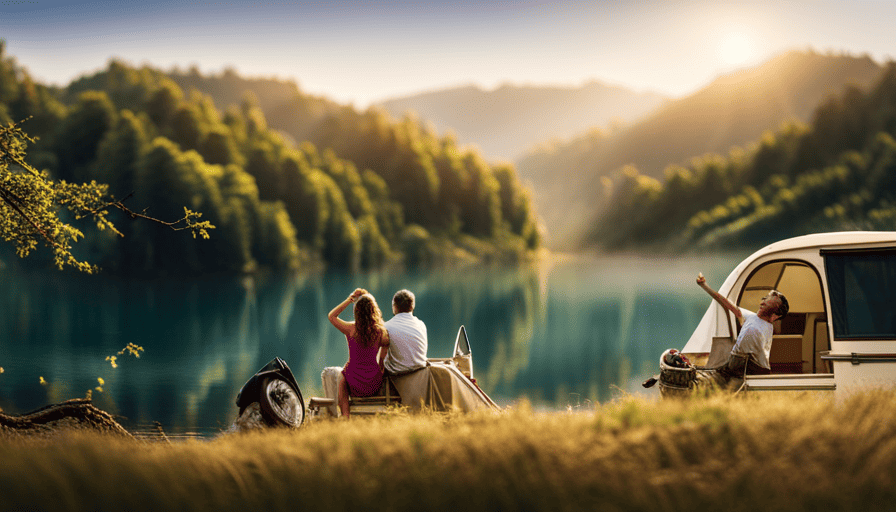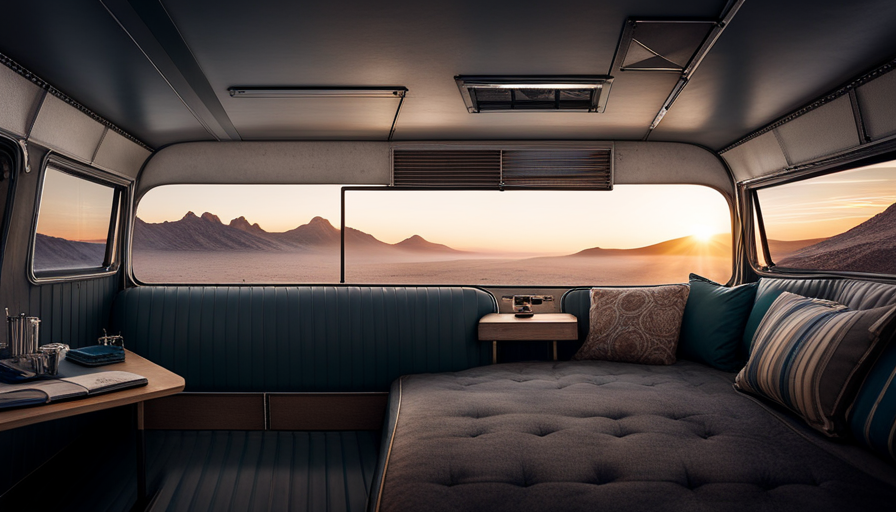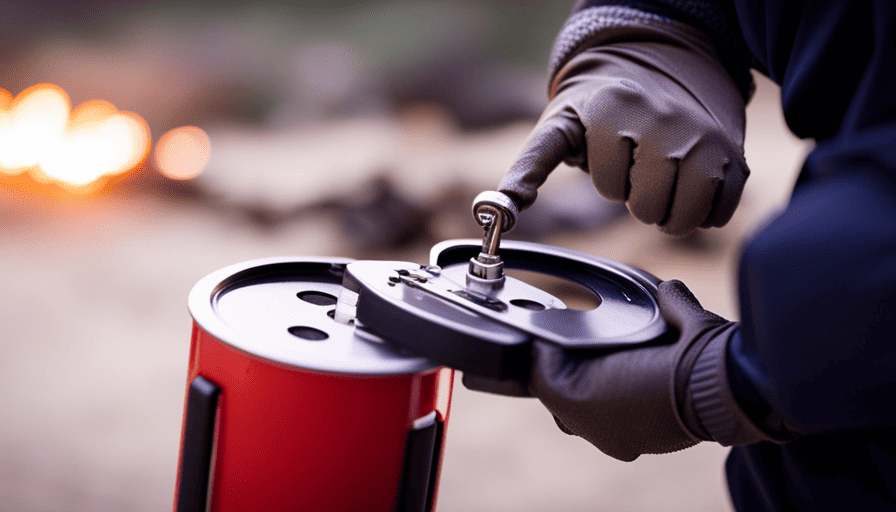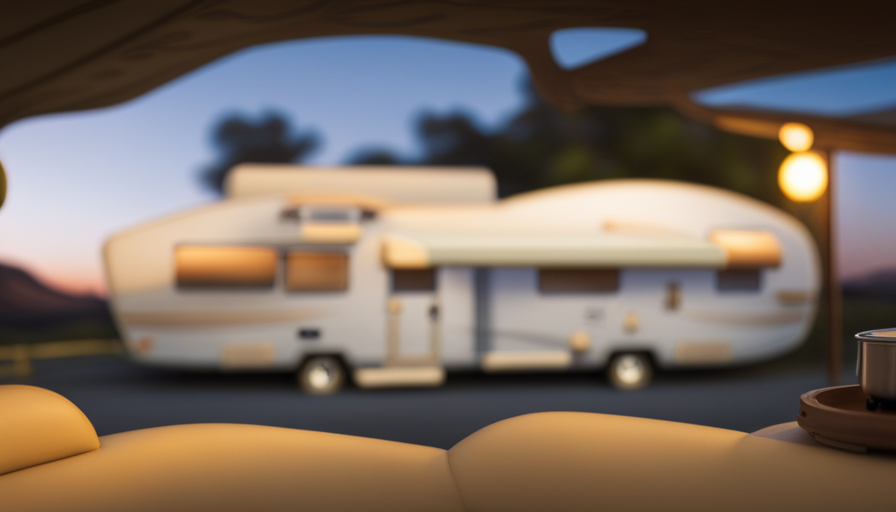You may have doubts – the concept of getting a camper for free may seem too good to be true. But rest assured, it is absolutely possible! In this article, I will share with you practical and detailed steps on how to obtain a camper without spending any money.
Now, I understand that you might be skeptical, thinking that it’s nearly impossible to find someone willing to give away a camper without any cost. However, with a little bit of effort and creativity, you can increase your chances of obtaining a camper without spending a dime.
From reaching out to friends and family, joining online camper communities, and looking for camper giveaways and contests, to volunteering at campgrounds or RV parks, exploring rental options, and utilizing online classifieds and marketplaces, there are various avenues to explore.
So, if you’re ready to embark on the journey of finding a camper for free, let’s dive in and explore these practical strategies together.
Key Takeaways
- Reaching out to friends, family, and online communities for borrowing options or community-based initiatives that lend out campers for free or at a reduced cost.
- Exploring camper donation programs, local buy/sell groups, and camper giveaways/contests to potentially win a free camper.
- Volunteering at campgrounds or RV parks for a chance to stay in a camper for free and gain experience that can lead to exploring camper rental options.
- Utilizing online classifieds, contacting local RV dealerships and manufacturers, and joining camper sharing programs or bartering platforms to find free or discounted campers.
Reach out to Friends and Family
If you want to score a free camper, start by reaching out to your friends and family. They may have a camper sitting in their driveway or storage unit that they no longer use. Borrowing options can be a great way to get access to a camper without having to spend any money.
Talk to your loved ones and let them know that you’re interested in borrowing their camper for a short period of time. Many people are happy to help out and lend their camper to someone they trust.
Another option to consider is community-based initiatives. Some communities have programs in place where they lend out campers to residents for free or at a reduced cost. These initiatives are usually aimed at promoting outdoor activities and encouraging people to explore nature.
Reach out to your local community center or city hall to see if they have any programs like this available.
By reaching out to your friends and family and exploring community-based initiatives, you can significantly increase your chances of finding a free camper. Once you’ve exhausted these options, it’s time to join online camper communities and continue your search for the perfect free camper.
Join Online Camper Communities
If you’re looking to get a camper for free or at a low cost, one great way to connect with potential opportunities is by joining online camper communities.
These communities are filled with fellow campers who may be looking to give away or sell their camper at a low cost.
By participating in camper forums and social media groups, you can stay updated on free camper opportunities and connect with others who share your passion for camping.
It’s a practical and informative way to find the camper you’ve been dreaming of.
Connect with fellow campers who may be looking to give away or sell their camper at a low cost
By connecting with like-minded campers who are eager to pass on or sell their campers at a bargain, you can hit the road with a new travel companion and enjoy the rhythmic hum of wheels on asphalt. Here are four practical ways to connect with fellow campers looking to give away or sell their campers at a low cost:
-
Explore camper donation programs: Many organizations offer camper donation programs where individuals can donate their used campers. Keep an eye out for these programs and reach out to see if there are any available campers.
-
Join local camper buy/sell groups: Look for local camper buy/sell groups on social media platforms or online forums. These groups often have members looking to sell their campers at a discounted price, making it an excellent opportunity to find a camper for free or at a low cost.
-
Attend camper meetups and events: Participate in camper meetups or events in your area. Connect with other campers and let them know you’re interested in finding a camper at a low cost or for free. They might have leads or be willing to sell their camper at a bargain.
-
Network through camper forums and social media groups: Engage in camper forums and social media groups dedicated to camping enthusiasts. These platforms are excellent for staying updated on free camper opportunities and connecting with fellow campers who may be looking to give away or sell their camper.
By actively participating in these camper communities, you can increase your chances of finding a camper for free or at a low cost. Now, let’s move on to the next section about participating in camper forums and social media groups to stay updated on free camper opportunities.
Participate in camper forums and social media groups to stay updated on free camper opportunities
Engaging in camper forums and social media groups will keep you in the loop about amazing opportunities to score your dream camper without spending a dime. Joining camper forums, social media groups, and online communities is a great way to connect with like-minded individuals who may be looking to give away or sell their camper at a low cost. These platforms provide a wealth of information on free camper opportunities, as well as tips and advice from experienced campers.
Additionally, exploring camper rental options can be a viable alternative to owning a camper outright. Many rental companies offer special promotions or discounts, allowing you to enjoy the camping experience without the hefty price tag. By staying active in these communities and considering rental options, you increase your chances of finding a camper for free.
So, once you’ve tapped into these resources, it’s time to look for camper giveaways and contests.
Look for Camper Giveaways and Contests
I always keep an eye out for contests and promotions where I can win a camper. It’s a great way to potentially score a free camper without having to spend a dime.
Whether it’s a local giveaway or a national sweepstakes, entering these competitions gives me a chance to fulfill my dream of owning a camper.
Keep an eye out for contests and promotions where you can win a camper
Hey, have you ever thought about entering contests or keeping an eye out for promotions that could land you a free camper? It’s a great way to potentially get your hands on a camper without spending a dime.
One strategy is to join camper clubs and attend camper rallies. These events often have contests or giveaways where you could win a camper.
Additionally, keep an eye out for promotions from camper manufacturers or dealerships. Sometimes they run special promotions where you have a chance to win a camper simply by entering a contest.
Another option is to enter local and national sweepstakes for a chance to score a free camper. These sweepstakes can be found online or in magazines.
So, if you’re dreaming of owning a camper but don’t want to break the bank, consider trying your luck with contests and promotions.
Enter local and national sweepstakes for a chance to score a free camper
Don’t miss out on the opportunity to hit the jackpot and set sail on the open road with your very own home on wheels by entering local and national sweepstakes for a chance to win the ultimate adventure companion.
Here are some tips for maximizing your chances in camper sweepstakes:
-
Research: Look for reputable sweepstakes with good odds of winning a camper. Check websites, social media platforms, and magazines for upcoming contests.
-
Enter regularly: The more sweepstakes you enter, the higher your chances of winning. Make it a habit to enter as many as you can, but be sure to read the rules and follow the entry requirements.
-
Stay organized: Keep track of the sweepstakes you’ve entered, deadlines, and any additional requirements. This will help you avoid missing out on potential wins.
-
Avoid common mistakes: Double-check your information before submitting entries to avoid disqualification. Also, be wary of scams or sweepstakes that require a fee to enter.
By following these tips, you’ll increase your chances of winning a free camper and embarking on unforgettable adventures. Speaking of adventures, another way to experience the RV lifestyle is to volunteer at campgrounds or RV parks.
Volunteer at Campgrounds or RV Parks
Volunteering at campgrounds or RV parks is a great way to score a free camper and immerse yourself in the vibrant camping community. Many campgrounds and RV parks offer volunteer opportunities and work exchange programs, allowing you to trade your time and skills for a chance to stay in a camper for free.
To find these opportunities, start by reaching out to local campgrounds and RV parks in your area. Ask if they have any volunteer positions available and explain your interest in trading your services for a free camper. Some places may require you to work for a certain number of hours each week, while others may have more flexible arrangements.
When volunteering, you can expect to perform a variety of tasks such as cleaning facilities, maintaining the grounds, assisting visitors, or even helping with administrative tasks. In exchange, you’ll typically be provided with a free campsite and access to amenities such as showers, laundry facilities, and Wi-Fi.
Once you have gained experience volunteering at campgrounds or RV parks, you can transition into exploring camper rental options. By immersing yourself in the camping community, you’ll have the opportunity to connect with other campers and potentially find leads on free or discounted camper rentals.
So, let’s dive into the world of camper rentals and discover more ways to get a camper for free.
Explore Camper Rental Options
Now, let’s dive into the world of camper rental options and discover how you can score yourself a cozy home on wheels without spending a dime. Renting a camper comes with a multitude of benefits, from the freedom to explore different locations to the convenience of having all the amenities you need in one place.
To help you find affordable camper rentals, here are some useful tips:
-
Compare prices: Research different rental companies and compare their rates. Look for discounts or special offers that may be available during certain times of the year.
-
Consider off-peak seasons: Renting a camper during off-peak seasons can often result in lower rental rates. Take advantage of this and plan your trips accordingly.
-
Join loyalty programs: Many camper rental companies offer loyalty programs that provide discounts or rewards for frequent renters. Sign up for these programs to save money in the long run.
By following these tips, you can find affordable camper rentals that won’t break the bank.
Now that you know how to find a camper to rent, let’s explore another option to get a camper for free – attending camper expos and trade shows. These events offer the opportunity to connect with industry professionals and potentially win a camper through contests or giveaways.
Attend Camper Expos and Trade Shows
When looking for free or discounted camper rental options, one practical approach is to attend camper expos and trade shows.
These events provide a great opportunity to connect with manufacturers and dealers who may offer promotional deals on campers.
By networking with industry professionals at these events, you may also gain insider information on potential free camper opportunities.
So, make sure to mark your calendar and take advantage of these valuable resources.
Visit expos and trade shows where manufacturers and dealers may offer free or discounted campers as part of promotions
To score a free or discounted camper, you can head over to expos and trade shows, where manufacturers and dealers often run promotions offering amazing deals.
One option is to attend RV conventions, where you can explore a wide range of campers and RVs all in one place. These conventions are a great opportunity to see the latest models and talk directly with manufacturers and dealers.
Another option is to check out camping equipment expos, where you can find not only campers but also various camping gear and accessories. Manufacturers and dealers often participate in these expos and may offer special discounts or even free campers as part of their promotions.
By attending these expos and trade shows, you can get firsthand information on the latest camper deals and potentially score a free or heavily discounted camper. And if you’re looking for even more insider information, network with industry professionals who may have valuable tips on free camper opportunities.
Network with industry professionals who may have insider information on free camper opportunities
After exploring the option of visiting expos and trade shows for free or discounted campers, I realized that there might be another potential avenue to explore. Networking with industry professionals who have insider information on free camper opportunities could be a game-changer.
These connections could provide valuable insights into upcoming promotions or events where campers are being given away. By tapping into this network, I could gain access to exclusive information that may not be available to the general public. This strategy requires building relationships with individuals in the industry and staying in touch to receive timely updates and tips.
With industry connections and insider tips, I would be well-positioned to seize any opportunities for a free camper. Now, let’s delve into the next approach: utilizing online classifieds and marketplaces to further expand our chances of finding a camper without spending a dime.
Utilize Online Classifieds and Marketplaces
Browse through online classifieds and marketplaces to find amazing deals on campers, where you can score one for free and embark on exciting adventures. These virtual platforms offer a vast selection of campers, ranging from brand new models to pre-owned gems waiting to be discovered. Here are some tips for negotiating prices and finding hidden gems:
-
Compare prices: Take your time to browse through different listings and compare prices. This will give you an idea of the average cost and help you identify any unusually low-priced options.
-
Be patient: Free camper opportunities may not be readily available, but with patience and persistence, you might stumble upon a generous seller looking to give away their camper for various reasons.
-
Act quickly: When you come across a great deal, don’t hesitate to reach out to the seller immediately. Free campers tend to be in high demand, and acting swiftly can increase your chances of securing one.
-
Consider local listings: Focusing on local listings can save you money on transportation costs and make it easier to inspect the camper before making a decision.
By utilizing online classifieds and marketplaces effectively, you can find that perfect camper and start planning your next adventure.
In the next section, we’ll explore how contacting local RV dealerships and manufacturers can also provide opportunities for obtaining a free camper.
Contact Local RV Dealerships and Manufacturers
When you’re ready to take your camper dreams to the next level, have you considered reaching out to local RV dealerships and manufacturers for potential opportunities?
RV dealership partnerships and manufacturer discounts can be valuable resources for obtaining a camper for free or at a reduced cost.
Start by contacting local RV dealerships and inquire about any partnership programs they may have. Some dealerships collaborate with individuals or organizations to promote their brand and offer discounted or even free campers in exchange for certain commitments or promotional activities. These partnerships can be a win-win situation, as you get a camper for free or at a reduced price, while the dealership benefits from increased exposure and marketing.
Additionally, contacting manufacturers directly can also lead to potential opportunities. Manufacturers often have demo models, refurbished campers, or discontinued models that they may be willing to offer at a discounted rate or even for free. Building a relationship with a manufacturer can open doors to exclusive deals and discounts that are not available to the general public.
Consider camper sharing programs as another option for obtaining a free camper. These programs connect camper owners who are willing to share their vehicles with others for a fee or in exchange for certain responsibilities. This can be a cost-effective way to experience the camper lifestyle without the initial expense of purchasing one.
Reaching out to local RV dealerships and manufacturers can provide opportunities for obtaining a camper for free or at a reduced cost. Additionally, exploring camper sharing programs can be a practical alternative.
Consider Camper Sharing Programs
Consider joining camper sharing programs to experience the joys of the camper lifestyle without the upfront cost of purchasing your own.
Camper sharing programs provide a unique opportunity to enjoy the freedom and flexibility of camping, while also meeting new people and exploring different destinations. One of the main benefits of camper sharing is that you can choose from a wide variety of campers, ranging from small trailers to luxurious motorhomes, depending on your needs and preferences. This allows you to try out different types of campers and see which one suits you best before making a long-term commitment.
However, it’s important to be aware of the risks associated with camper sharing. While most programs have insurance policies in place to protect both the owner and the renter, accidents and damages can still occur. It’s essential to carefully read the terms and conditions of the sharing program and ensure that you fully understand your responsibilities as a renter.
Camper sharing programs offer a fantastic opportunity to experience the camper lifestyle without the financial burden of purchasing your own camper. By joining a sharing program, you can enjoy the benefits of camping while also meeting new people and exploring different destinations. However, it’s important to be aware of the risks involved and take necessary precautions.
Now, let’s explore how to get creative with bartering and trading to acquire a camper without spending any money.
Get Creative with Bartering and Trading
If you’re looking to get a camper for free, one creative option is to offer your skills or services in exchange. For example, if you’re a skilled carpenter, you could offer to build or repair something for someone in exchange for a camper.
Another option is to explore bartering platforms and communities where you can trade items or services for a camper. There are online platforms and local communities where you can connect with people who may be interested in trading their camper for something you have to offer.
It’s a practical and resourceful way to get a camper without spending any money.
Offer your skills or services in exchange for a free camper
One great way to score a free camper is by offering your skills or services in exchange. There are various alternative ways to acquire a camper for free, and by showcasing your talents, you may find someone willing to trade. Here are some ideas to consider:
-
Offer to provide handyman services, such as fixing electrical issues or plumbing problems, in exchange for a camper.
-
If you have culinary skills, you could offer to cook meals or cater events for the camper owner.
-
If you have a green thumb, propose maintaining their garden or landscaping in return for the camper.
By offering your skills or services, you not only demonstrate your value but also create a mutually beneficial arrangement. Exploring bartering platforms and communities where you can trade items or services for a camper is another effective way to find free camper opportunities.
Explore bartering platforms and communities where you can trade items or services for a camper
Take a stroll through online bartering platforms and communities, where a world of possibilities awaits to exchange your items or services for the camper of your dreams. One popular option is to participate in a "swap meet" where you can connect with individuals who are willing to trade their camper for something you have to offer. These platforms provide a convenient way to find potential camper trade opportunities and negotiate a fair exchange. Additionally, don’t overlook the power of "Craigslist connections" as it is a widely used online classifieds and marketplace where you can find people looking to trade or sell their campers. By exploring these bartering platforms and communities, you can increase your chances of finding a camper for free by leveraging your skills or possessions.
Here is a table that provides a visual representation of ideas for finding a camper through bartering platforms and communities:
| Bartering Platforms & Communities |
|---|
| Swap Meets |
| Craigslist Connections |
| Online Bartering Forums |
Frequently Asked Questions
Are there any legal considerations or restrictions to keep in mind when obtaining a camper for free?
When it comes to obtaining a camper for free, there are definitely legal considerations and zoning restrictions to keep in mind. It’s important to understand and abide by the laws and regulations of your specific area.
Legal considerations may include obtaining proper documentation and ensuring the camper meets safety standards. Zoning restrictions may dictate where you can park or store the camper.
Familiarizing yourself with these factors will ensure a smooth and hassle-free experience.
How can I ensure that a free camper is in good condition and safe to use?
To ensure that a free camper is in good condition and safe to use, here are some tips.
Firstly, look for free camper giveaways or contests online or in local classifieds.
When considering a camper from a private individual, inspect it thoroughly for any damages or issues.
On the other hand, getting a free camper from a dealership may provide more peace of mind as they often conduct thorough inspections.
Remember to weigh the pros and cons of each option before making a decision.
Are there any additional costs or expenses to expect when getting a camper for free?
When obtaining a free camper, it’s important to consider the potential hidden costs and maintenance expenses involved. While the initial acquisition might be cost-free, there are additional expenses to anticipate.
Regular maintenance, such as oil changes, tire replacements, and cleaning supplies, can quickly add up. Additionally, you may need to invest in insurance coverage and registration fees.
It’s crucial to budget for these ongoing costs to ensure that your free camper remains safe and functional.
What are some alternative ways to find a free camper if the methods mentioned in the article do not work?
If the methods mentioned in the article don’t work, there are still alternative ways to find a free camper.
One option is to join online forums or groups dedicated to camping and RVs. These communities often have members looking to give away or sell their campers at a low cost.
Another tip is to keep an eye out for local events like garage sales or auctions where campers might be available at a discounted price or even for free.
With some patience and persistence, you can find a free camper using these tips and tricks.
Are there any specific qualifications or requirements I need to meet in order to be eligible for a free camper?
To be eligible for a free camper, there may be certain qualifications and eligibility requirements that need to be met. These can vary depending on the organization or program offering the camper. It’s important to consider legal considerations and restrictions that may apply. Additionally, the condition and safety of the camper should be carefully assessed.
It’s also worth noting that while the camper itself may be free, there could be additional costs for maintenance, repairs, or insurance. If traditional methods don’t work, alternative methods such as networking or joining online communities can be explored.
Can You Use the Method of Getting into a Locked Camper to Get a Camper for Free?
Unlocking a camper can be a viable method to acquire one for free, but it is crucial to respect legal boundaries and personal belongings. Engaging in any unauthorized activity may lead to serious consequences. It is advisable to explore alternatives such as renting or investing in a camper, ensuring a safe and legitimate acquisition process.
Conclusion
In conclusion, getting a camper for free isn’t impossible if you’re willing to put in some effort and think outside the box. By reaching out to friends and family, joining online communities, participating in giveaways, volunteering, exploring rental options, using online classifieds, contacting local dealerships, and considering sharing programs, you can increase your chances of finding a camper without spending any money.
Remember, the journey to a free camper may require some creativity and persistence, but the reward of hitting the open road is worth it. So, get out there and start your camper adventure today! As they say, "The world’s your oyster!"











